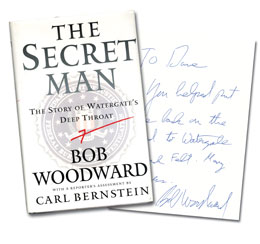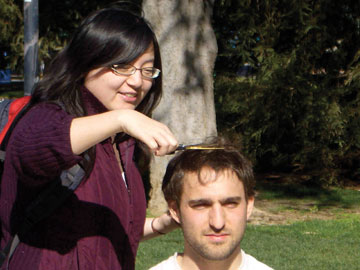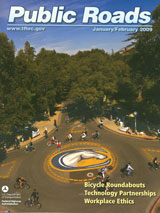Volume 26 · Number 3 · Spring 2009

End Notes
The Davis Link to Deep Throat’s ID
The death of W. Mark Felt last December brought the revelation that UC Davis and its manager of speaker programming, Dave Webb, played an unwitting role in uncovering Felt’s identity as Deep Throat, the famous unnamed source in the Watergate scandal.
Webb’s story appeared in the Sacramento News & Review (where his wife, Melinda Welsh, is editor): In 2000, Webb arranged for the Washington Post’s Bob Woodward to speak at Freeborn Hall. Webb didn’t know it at the time, but after his speech Woodward went to Santa Rosa to visit his old source, whose identity he had protected for more than 30 years. Felt, a former FBI deputy director, revealed to Vanity Fair in 2005 that he was Deep Throat—whose leaks about the Watergate break-in helped bring down President Nixon. An autographed copy of Woodward’s 2005 book, The Secret Man, later arrived in the the mail for Webb with the incription: “To Dave, You helped put me back on the road to Watergate and to Mark Felt. Many thanks, Bob Woodward”

(Photo: Logan Williams)
Change: one snip at a time
For his art, junior Tommy Anker was willing to suffer…a really bad haircut. For a performance-art assignment in a theatre course, Anker sat at the center of the Quad for an hour one day and invited passersby to snip his hair. “Change . . . this man’s hair,” read a hand-written cardboard sign at his feet.
Each person was allowed one snip, but not everyone picked up the scissors. “A lot of people ignore me and walk by,” Anker, a genetics major and theatre minor, said during his noon act. “A lot of [other] people stop to find out what it’s about and don’t participate. I think maybe they’re afraid of touching my hair.” Most of those who did participate made small cuts, and Anker kept most of his hair. “People were kind,” Anker said later.
Two of Anker’s friends recorded the performance. Fifth-year exercise biology major Mike Sun of Palo Alto shot video and second-year film and technocultural studies double-major Logan Williams of Sacramento took photos. A resulting video, “Change,” can be viewed on YouTube.
— Kathleen Holder
Lessons from The Daily Show
Jon Stewart of Comedy Central’s The Daily Show interviewed UC Davis transportation expert Dan Sperling in February about Sperling’s new book, Two Billion Cars: Driving Toward Sustainability. You can watch the interview on The Daily Show's Web site. But Sperling’s publisher, Oxford University Press, got the inside scoop for a blog with questions like these:
Q: Do you watch The Daily Show and have you ever fantasized about being a guest?
A: “Yes, I watch, but I never even fantasized about being a guest — even though all my friends and students now say I have reached the highest state of coolness; one (young) professor friend now says he idolizes me.”
Q: What was the green room like?!
A: “Perfectly comfortable and pleasant, but way overhyped. Light green walls, flat screen TV, sofa, bag of goodies (the best being a Jon Stewart cap and T-shirt).”
Sperling is a professor of civil engineering and of environmental science and policy, and founding director of the UC Davis Institute of Transportation Studies.

We get Around
UC Davis gets a good ride and teaches Stanford a lesson in the January-February issue of Public Roads magazine, published by the Federal Highway Administration.
The cover story is about the increasing popularity of bicycle roundabouts, something in which UC Davis is a pioneer — having put in the campus’s first traffic circles in the 1970s. The very first one is in the intersection closest to the 194 Chemistry lecture hall.
“The university didn’t do any formal studies, but you could just sit there and observe the improvements in traffic flow,” David Takemoto-Weerts, coordinator of the campus’s bicycle program, told the magazine. “It was pretty impressive.”
Today there are 11 roundabouts on the Davis campus, and planners are considering a half-dozen more.
The magazine’s front and back covers feature UC Davis photos. And the article says the campus’s success with roundabouts has prompted other colleges and universities to build their own, for improved safety and mobility. Indeed, Stanford hopped on the bandwagon in 2007, building a traffic circle at a pedestrian-bicyclist crossroads known as the “Intersection of Death,” according to the article.
— Dave Jones
